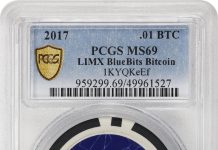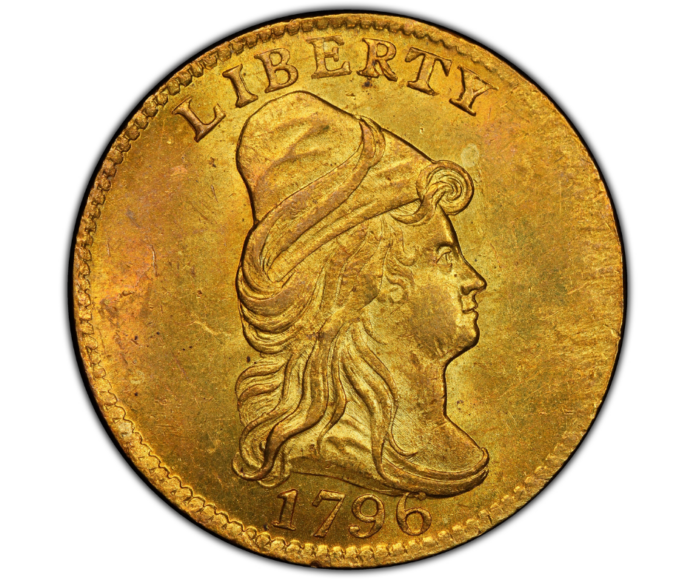
Classic American gold coins or “old tenor gold coins” (1795- 1834) are the ultimate collector coins. This has been one of the most stable areas of numismatics. The demand for choice specimens has been increasing ever since I became seriously involved in coins in 1973.
The allure of gold is worldwide, as it is money. Central banks use it as a store of value, and collectors know the most valuable coins are our gold coins. The early United States gold coins in high-grade should always be in demand. They often are the highlight of collections. I believe they will continue to rise in value, as more collectors enter the marketplace.
One can tell when a particular series is undervalued, as they disappear from dealer inventories. In the last few years, the number of choice, high-grade early gold coins has almost vanished from the marketplace. There is nowhere to go but up for prices, as those who hold these coins seldom sell them. They are numismatic treasures that will continue to appreciate.
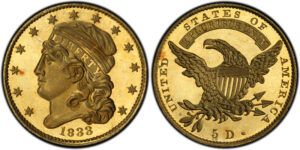
Writing the Book
In 2005, when David Calhoun of the Harry Bass Foundation asked me to write a book on early United States gold coins based on Mr. Bass’s notes, I immediately accepted.
The late Harry Bass, Jr. assembled a landmark, historic collection of early U.S. gold coins. He also ran an oil company, invested in a ski resort and had an interest in computer science. The Harry Bass Foundation preserves his legacy through philanthropy. In May 2023, the foundation gave a gift of $40 million to the University of Texas at Dallas.
The original Harry Bass Foundation was created by Harry Bass, Sr. During his lifetime, Harry Bass, Jr. managed two foundations: the one created by his father and one he created himself, the Harry W. Bass, Jr. Research Foundation. Upon the death of Harry Bass, Jr., the two organizations were merged to form the Harry Bass Foundation d/b/a Harry W. Bass, Jr. Foundation.
The Ultimate Collector
I had a casual relationship with Harry Bass, Jr., the ultimate collector of early gold. During the 1982 Bowers & Ruddy auction lot viewing of the landmark Louis Eliasberg gold coin collection in 1982, I spent two days next to Harry looking at that fabulous gold collection.
Louis Eliasberg (1896-1976), a celebrated numismatist in his own right, was a Baltimore financier who assembled possibly the only complete collection of United States coins, with attention to coins in the highest grades.
Bringing His Collection to Auction
Mr. Bass is the only person I have ever seen who was allowed to bring his collection to an auction to compare his coins to the ones being sold. Each day, Harry brought boxes of his coins to the viewing and would remove them from their envelopes when he saw an Eliasberg coin that he thought might be higher grade than his coin. He would pick up the lot from the sale and examine it and then look at his coin. He would then jot down his opinion in his catalog. Recently, in an interview with one of the dealers that he used for proxy bidding at auction, Julian M. Leidman, said Mr. Bass would remark that a coin was “needed,” or “really needed” or a “have-to-have-it” issue.
I later was told that famed coin dealer and numismatic scholar Q. David Bowers had placed me next to Harry on purpose, as he knew I was interested in die varieties. Harry Bass had acquired all 29 varieties of the pre-1834 old tenor gold quarter eagles, 133 of the 143 collectible half eagles, and 32 of the 33 eagles. This was the most complete set of early gold coin varieties ever assembled.
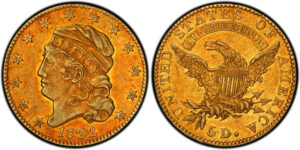
Attempting to Assemble a Full Set
Waldo Newcomer, the early twentieth-century collector, is the only other collector to attempt a die variety set of our first gold coins. For the half eagles, Newcomer obtained 123 varieties, a remarkable feat for a period when there was almost no literature on die varieties of any denomination. The Bass Core Collection of die varieties had been on display at the American Numismatic Association Money Museum for over 20 years until the foundation decided to sell it and put the money to good use with its charitable foundation.
In a series of four sales that began in 2022, the collection is being dispersed to a new generation of collectors. It is, literally, a once-in-a-lifetime opportunity. Some of the greatest early gold rarities are finding new homes with today’s collectors. Rarity after rarity is crossing the auction block, and many are bringing record prices – not surprising as Mr. Bass had quite an eye for quality.
Yes, he was interested in the die varieties, and even die states (he often had several coins of the same variety in different die states), but he also bought many finest known coins. When he passed away in 1998, there were over 600 pre-1834 old tenor gold coins in his collection.
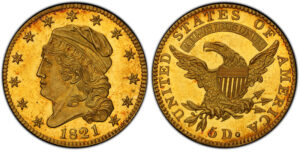
COURTESY PROFESSIONAL COIN GRADING SERVICE
1821 Half Eagle Gold Coin Sells for $4,620,000
One did not have to wait long for record prices for some of the highlights from the Bass Core Collection.
In September 2022, the Professional Coin Grading Service (PCGS) superb gem Proof-65 Cameo 1821 half eagle set a record for an early half eagle Proof, as it brought $4,620,000 at the Heritage Auctions (HA.com) Long Beach sale.
PCGS grades or rates coins on a one through 70 scale, where one refers to a coin barely identifiable as to its type, and 70 is perfect. 65 is a Gem. A brilliant proof coin is made by the mint, especially for collectors using specially polished dies to assure a magnificent brilliance and often a cameo appearance between the fields (background of the coin) and devices (the part that stands out, such as lettering and portrait).
This was the first major auction that was held as a live event after the hiatus caused by the pandemic. Over 100 lots were sold that night at an average of nearly $100,000 per lot.
Book Writing Made Easy
Writing the book on early United States gold coins would have taken years of research if the foundation had not provided me with Harry’s notes on all his early gold varieties. A secretary had entered all his little card notes into a Microsoft Word file and emailed it to me. He wrote very small block letters on the two by two cards placed in the envelopes with his coins. This saved countless hours of research as his multiple die states of many varieties had precise notes of the characteristics.
I assembled these and was able to identify the varieties for the reader and list nearly all the die states for every coin. Auction cataloguers have sent emails noting a few new die states, but Harry’s extensive collection had nearly every known die state or he had observed them at some point. Going through auction catalogs, I was able to varietize another 8,900 coins from photographs. So the rarity of each variety was estimated. Thus, in 2005, Harry’s “book” he planned to write became a reality, as Whitman Publishing released the Bass-Dannreuther Early United States Gold Coin Varieties, 1795-1834.
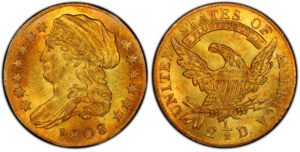
Mint Act of 1792 Specified Three Gold Coin Denominations
Collectors have treasured these early examples of our first gold coinage. The Mint Act of 1792 specified three gold coin denominations – the eagle equal to 10 dollars and the quarter and half eagle of two-and-a-half dollars and five dollars. No denomination was stated on the coins at first, as money traded by the “tale” at the time with the weight and purity determining value. It would be 1807 before the half eagles had a denomination on the coins and 1808 for the quarter eagles.
The eagles were discontinued as a denomination in 1804 – an attempt to stop the exporting of our gold coins. That is another story, as the 15 to one ratio of gold to silver was below the market ratio that soon after 1795 moved closer to 16 to one. That is why these are called old tenor gold coins, as it would be 1834 before this inequity was remedied by a law changing to a nearly 16 to one silver to gold ratio.
First Quarter Eagle
The first quarter eagle, the 1796 No Stars variety in PCGS MS65 that did not have a stated denomination, and an 1808 quarter eagle in PCGS MS65 after the denomination was added. Both are the finest known of their type. Fully original and lustrous early gold coins are among the most desirable of all United States coins.
Although no eagles were struck after 1804 and no quarter eagles from 1809 until that denomination reappeared in 1821, the workhorse denomination, half eagles, were struck every year from 1795 to 1834 except 1816 and 1817. As noted, many early gold issues were exported and melted as their bullion value exceeded their face value. They are much rarer than their mintages indicate, with some issues excessively rare, such as 1822 when nearly the entire mintage was lost to gold and silver arbitragers.
Affordable Examples Available
Despite their scarcity, there are enough examples that exist to make them affordable to many collectors. One can obtain a nice Extra Fine or Almost Uncirculated early half eagle, although they are beyond the means of some collectors. Having one early gold coin, however, instead of two or three common date double eagles will benefit the collector in the long run. You can own an impressive piece of early American history that has a great track record.
These coins have been appreciated since collectors became more plentiful after the discovery of gold in California and elsewhere in the states. The wealth the gold discovery provided not only created new coin collectors, it made the United States the leader of the Industrial Revolution. Europe was the center of creativity to begin the changes, but the United States took the baton and many of the innovations sprang from the minds of the American entrepreneurs.
Old Tenor Gold Coins Melted
The old tenor gold coins were also melted in America, as well as Europe, after the change in 1834, so these early issues survived only in collections and accumulations in very limited quantities. The eagles are the most magnificent of the early gold issues with coins struck only from 1795 to 1804. These large coins survived in much smaller quantities than the half eagles, so they are more expensive, of course.
One Rare Gold Coin vs. Many Common Gold Coins
Having a single early eagle will be the highlight of many collections, so saving up to purchase a single coin will serve the collector well in the long run. They have established value over a long period and are always in demand. Although most collectors cannot afford an uncirculated example, a nice Very Fine or Extra Fine coin such as the PCGS XF40 can be obtained for the price of five or six common date double eagles.
It is much more impressive to have a Turban Head eagle from the eighteenth or early nineteenth century than a group of similar-looking double eagles. Do not misinterpret this to mean that buying double eagles is a bad thing. I love all gold coins and, as a dealer, handle many common date gold issues. The collector in me believes that the beauty of these early issues makes them among the most desirable United States coins. Owning a coin that was used in the fledgling United States commerce is a thrill for any collector. It is part of the history of this great nation.
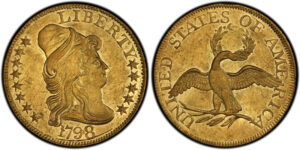
Owning is Within Your Reach
Just as copper and silver enthusiasts love the early large cents and Capped Bust silver coinage, those who like gold coins are drawn to these beautiful and historical issues. When these early quarter eagles, half eagles, and eagles were the coins of the realm, they were used in transactions for real estate, goods, and other major deals. Most collectors can never hope to put together a date set of early quarter eagles, half eagles, or eagles, much less a die variety set such as Waldo Newcomer or Harry Bass did. However, owning one or two early gold coins is within your reach.
Buy The Best You Can Afford
The advice of buying the best coin you can afford in whatever series you collect is always the correct approach. Buying a coin that you like will be satisfying in the future. If you do not like it at the time, it will not improve. Coins are one of the most rewarding in the collectibles field, as everyone understands money. We daily conduct monetary transactions. With most of today’s purchases with digital currency, the past “hard money” will always be appreciated. To this writer, there are no more impressive coins than our earliest gold coins. The old tenor gold coins have it all. They have beautiful and impressive designs, as well as being the earliest dated gold coins of our country. They were the foundation of the economy and represent the history of our great nation.
My favorite numismatic quote of all time comes from the 1913 Adams-Woodin pattern book. In their introduction, they begin with the sentence: “Coins are the metallic footprints of nations.” Yes, we have a greater understanding of history from the study of coinage. We cannot go back in time and relive the past. With the coins of this era, one can appreciate the money that was used to facilitate commerce and build our country.
This article about early gold coins previously appeared in COINage magazine. To subscribe click here. Article by John W. Dannreuther.


